page 29
Note: the contents of this page as well as those which precede and follow, must be read as a continuation and/or overlap in order that the continuity about a relationship to/with the dichotomous arrangement of the idea that one could possibly talk seriously about peace from a different perspective as well as the typical dichotomous assignment of Artificial Intelligence (such as the usage of zeros and ones used in computer programming) ... will not be lost (such as war being frequently used to describe an absence of peace and vice-versa). However, if your mind is prone to being distracted by timed or untimed commercialization (such as that seen in various types of American-based television, radio, news media and magazine publishing... not to mention the average classroom which carries over into the everyday workplace), you may be unable to sustain prolonged exposures to divergent ideas about a singular topic without becoming confused, unless the information is provided in a very simplistic manner.
Let's face it, humanity has a lousy definition, accompanying practice, and analysis of peace.
Let us take another look at Thomas Young's Two-slit experiment by replicating the feature of pronouncing it as an anthropomorphism (in that the two slits are seen as two eyes), that were done on pages 25 and 26 in this series. First, let us again present a description of the experiment:
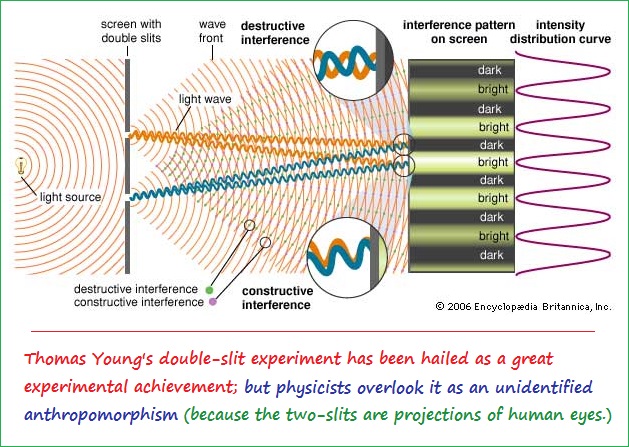
But some readers may have difficulty in visualizing the two slits as being eyes, so the next image makes it easier to see the experiment not only as an illustrated anthropomorphism, but that the human (biological) set-up is an evolutionary type of experiment obtaining a similar dual-patterned image denoted by examples of various ideological contrasts:
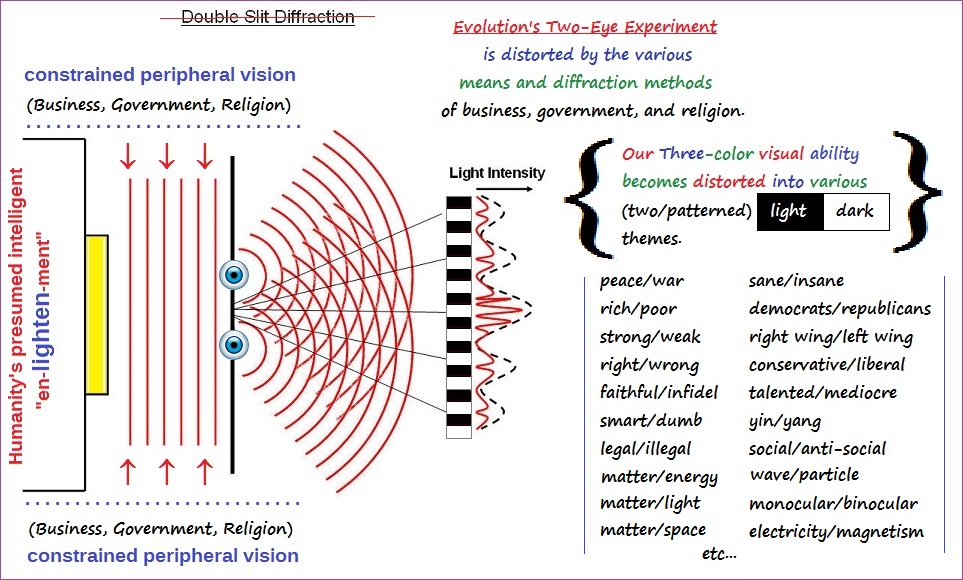
Now let's expand the idea and move into the "threesological" realm consistent with having three types of cone (red, blue, green) and one type of rod which distinguishes between the size, shape, and brightness of visual images:
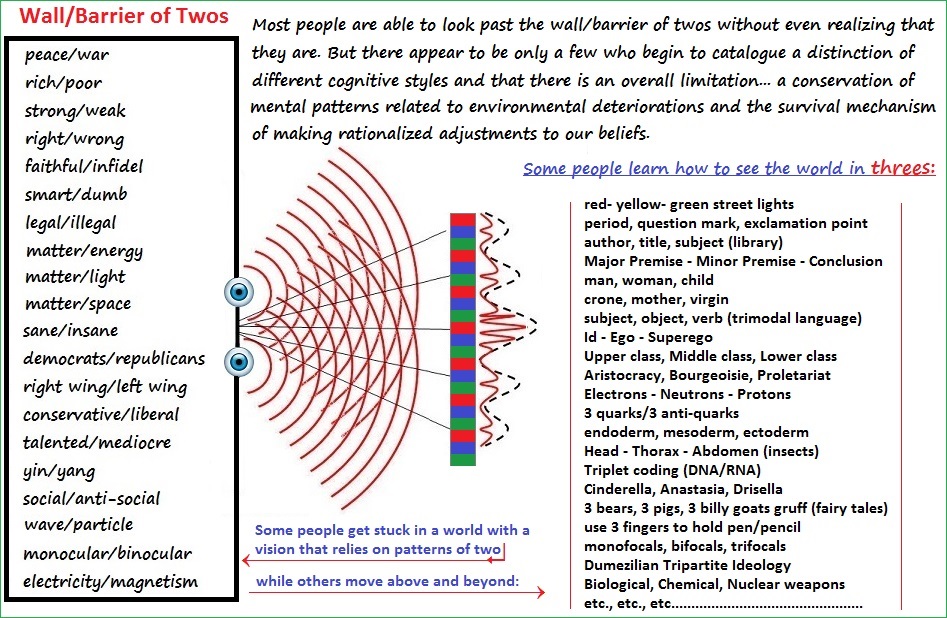
Now let's show an image regarding the "wall of two-patterned views" next to the "gateway of three-patterned views" ...and then some:
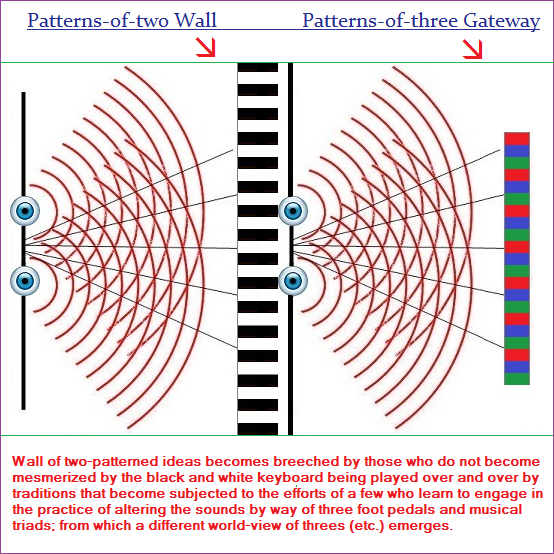
Now, let's add an image describing the developmental change in human cognition which appears to have followed a course of the self-centered "one", to a two-patterned "me/mine", "us-them", to a three-part orientation which began with a one such as "me- myself- I", to a two-patterned (externalized) three-some such as "Father- Son (Sun)- Holy Spirit", to those who have acquired a perspective of acknowledging multiple patterns-of-three, but are still culturally attached to many uses of two-patterned views... but are none-the-less attempting to transition into the next evolutionary stage of cognitive development:
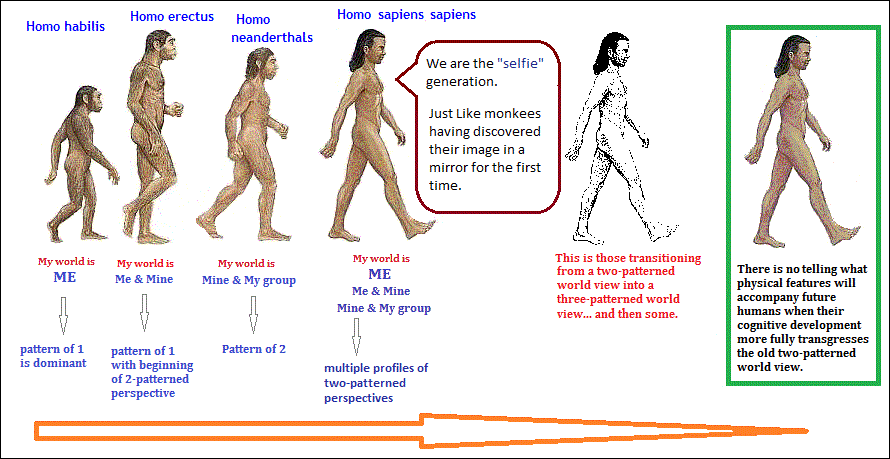

Interestingly, there is some fossil evidence to suggest that there was a change in physical features prior to a change in the human brain (and thus perhaps cognition), or at least this is the interpretation made with respect to the fossil known as Lucy. However, Anthropologists are rather inclined to think in terms which describe human cognitive progress according to standards which may not reflect a numerical identification that doesn't use conventional numbers. For example, complexity might be shown in abstractions such as from a linear (such as a stick), to a circular (such as a stone), to a triangular (such as using a stick to uncover a rock shaped like a triangle from which later emerged a knife, spear... or arrowhead.) Brain size alone may not describe subtleties of developmental cognitive complexity. (See examples of linear, circular, triangular ideas below.)
(Lucy is) nickname for a remarkably complete (40 percent intact) hominin skeleton found by Donald Johanson at Hadar, Eth., on Nov. 24, 1974, and dated to 3.2 million years ago. The specimen is usually classified as Australopithecus afarensis and suggests—by having long arms, short legs, an apelike chest and jaw, and a small brain but a relatively human-like pelvis—that bipedal locomotion preceded the development of a larger (more human-like) brain in Hominin evolution. Lucy stood about 3 feet 7 inches (109 cm) tall and weighed about 60 pounds (27 kg).
Source: "Lucy." Encyclopædia Britannica Ultimate Reference Suite, 2013.
Here are a few examples of Linear, Circular, Triangular expressions:
| "3" Basics Formula | Linear | Circular | Triangular |
| 3 galaxy/universe items | Our galaxy through space | Motion of galaxy | Expansion/Contraction {<>,X} |
| 3 basic Earth motions | Earth+Moon+Sun | Rotation of Earth | Precession of Earth's axis |
| 3 forms of matter | Liquid | Solid | Gas |
| 3 fundamental forces | (N)electro-magnetism(S) | Gravity | Nuclear (+)(-)(+/-) |
| 3 conceptual models: A dual form of singularity A circular form of duality A plurality of threeness |
Primitive (Singularity) |
Native American (Duality) |
Indo-European (Trianguality) |
| 3 (hair) cross-sections | African: ribbon-like | Asian: circular | Caucasian: ellipsoid |
| 3 Earth shapes | Earth is flat | Earth is round | Earth is a triaxial ellipsoid |
| 3 Universe theories | Universe is flat | Spherical | Saddle (triangular)-shaped |
| 3 physics ideas | String theory | Particle theory | Multi-dimensional theory |
| 3 stone tool shapes | Mono-facial | Bi-facial | Tri-facial (arrow heads) |
| 3 counting objects | Lines (on bones, rocks, etc.) | Pebbles, stones, (clay,etc.) | Cones (wedges) |
| 3 engineering tools | Lever | Pulley/Wheel | Fulcrum |
| 3 engine shapes | In-line, Slanted, etc... | Radial, Rotary | V-shaped |
| 3 shapes game | Paper (flat-linear) | Rock (round-circular) | Scissors (X-shaped/triangular) |
| 3 human face items | Eyebrows | Eyes | Nose |
When we look at the faces carved on pumpkins during the Halloween season, we see a repeated and interchangeable usage of linear, circular and triangular eyes, mouth, and nose. Not to mention that most pumpkins have a circular shape, most knives have a linear shape, and that some readers may use an argument suggesting a "triangular" opposition to explain this example way. (Thinking in terms of a triangular relationship that always results in conflict.) |
|||
| 3 playground items | Monkey bars/See-saw | Merry-go-round | Slide/Swing-set support |
| 3 in-vehicle views | Road, Stick shift, etc... | Steering wheel | Perceptual view of distance |
| 3 early industry tools | Staff, Poker | Pottery wheel, Kiln | Fire (flame), Bellows |
| 3 pre-industry tools | Stick | Rock | Fire (flame) |
| 3 cyanobacteria shapes | Filamentous (string-like) | Coccoidal (ball-like) | Ellipsoidal (egg-shaped) |
| 3 stromatolite shapes | Flat-layered | Domical/Columnar | Conical |
| 3 building structures | Skyscrapers | Coliseums Stadiums,etc. |
Pyramids |
| 3 foot descriptions | Heal to Toe line | Balls of feet | Arch of foot |
| 3-in-1 necktie forms | Fronts-piece covers buttons | Encircles the neck | Triangle slip knot |
| 3-in-1 washing machine cycle status symbols Speed Queen Commercial washer Model # SWT91QN |
In Use (vertical line) |
Spin (circular "curlicue") |
Rinse (triangular water shape) |
| 3 bird-flight formations | Diagonal, Horizontal, Vertical | "Bunched up" | V-shaped (also J/L/7 variations) |
Note: I used the symbols {><} and {X} to portray expansion and contraction. Did the Universe expand like a bursting ball in all directions or a selected direction? It is not certain if the "Big Bang" occurred at a single point and then expanded in all directions. Unless we care to consider that our Universe is the result of an implosion, which is 1 idea, then there are 3 other theories we can consider, which brings our overall formula to a 3:1 ratio. The other three being a Linear- Circular- Triangular expansion after the Big Bang. Also, if the expansion is slowing down, is there to be an eventual "Big Crunch?"
Stromatolites are the result of mat-building communities of mucilage-secreting micro-organisms that have been on the Earth for billions of years. The key micro-organisms in modern Stromatolites are cyanobacteria. The most common forms of cyanobacteria are string-like (filamentous), ball-shaped (coccoidal), and egg-shaped (ellipsoidal). Hence, we have Linear, Circular, and Triangular forms:
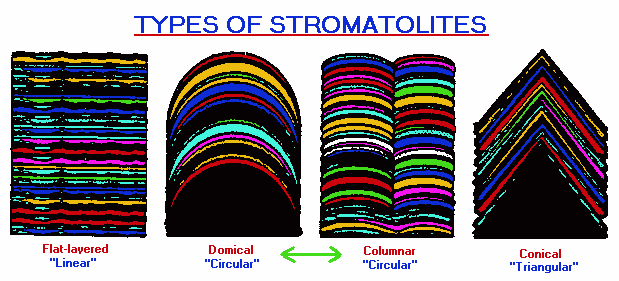
The Domical and Columnar forms are said to grade into one another. The overlapping of these two would thus provide us with 3 types of Stromatolites:
- Flat~
- Domical/Columnar~
- Conical.
If we consider that all forms tend to overlap developmentally, in terms of overall evolutionary processes, then we have a single origin probability.
On a level of life with a more complex biological structure and yet still very much in the realm of simplicity, take a look at the following sequence of pictures illustrating a spider at work designing a web. We can recognize the usage of (single) linear, circular, and triangular forms that overlap which display vertical, horizontal and diagonal linkages. While some readers might argue that these are merely basic designs in nature and that there are numerous other examples we could provide, they overlook that this is the very point being made with respect to the Linear ~ Circular ~ Triangular forms. These basic forms, in overlapping succession, may well be the forms characteristic of how consciousness develops.
However, instead of these geometric patterns being used, they may be substituted with other configurations such as numbers, letters, sounds, sights, sensations, etc... An organism, such as humans, that is capable of complex mental activity, will no doubt express such basic forms particularly suited for the human species. A species whose developmental evolution is being subjected to environmental processes of incremental decay creating a situation in which beliefs and world-views are adapted by way of adjusted rationalizations. However, not all human individuals share the same capacity for complexity of thinking. Likewise, different spiders use different "symbols" such as web construction. Some spiders have not developed the ability to construct and utilize such elaborate structures:

Additionally, let us recall the usage of such basic forms on playgrounds in the form of linear monkey bars/see- saws, circular merry-go-rounds, and triangular- shaped slides. (Not to mention the linear/triangular configuration seen while a child is either sitting motionless on a swing, or engaging in the pendulum creations of a triangular illustration when in motion.) A tethered-to-a-pole ball (tether ball) could be viewed as representing a composite of linear, circular, and triangular forms, with the triangle being seen as the angle between tether line and pole when the ball is held out at a distance in preparation for a serve to an opponent player. No less, we can see the linear ~ circular ~ triangular configuration in a lawn sprinkler system to the extent that the connecting pipes are linear, the sprinkler head (in some set-ups) is circular, and the triangle image is seen when the water comes out of the sprinkler head.
Source for above examples: Introduction (to Threesology) page 3cLet us look a little closer at Australopithecus because of the importance in getting some idea of the developmental transitions humanity has undergone and may retain from one generation to the next... not only in body, but mind and spirit.
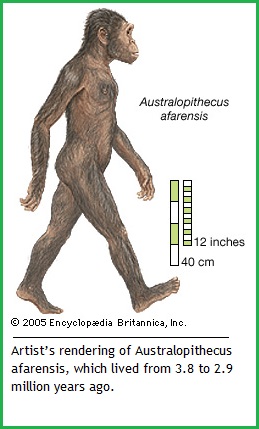
("Australopithecus" is Latin for "southern ape", and refers to a) group of extinct creatures closely related to, if not actually ancestors of, modern human beings and known from a series of fossils found at numerous sites in eastern, central, and southern Africa. The various species of Australopithecus lived during the Pliocene (5.3 to 2.6 million years ago) and Pleistocene (2.6 million to 11,700 years ago) epochs. As characterized by the fossil evidence, they bore a combination of human- and apelike traits. Like humans, they were bipedal (that is, they walked on two legs), but, like apes, they had small brains. Their canine teeth were small like those of humans, but their cheek teeth were large. The genus name meaning “southern ape” refers to the first fossils found, which were discovered in South Africa. Perhaps the most famous specimen of Australopithecus is “Lucy,” a remarkably preserved fossilized skeleton from Ethiopia that has been dated to 3.2 mya. The general term australopith (or Australopithecine) is used informally to refer not only to members of the genus Australopithecus but also to other human-like primates that lived in Africa between 6 and 1.2 mya. Other australopiths include Sahelanthropus tchadensis (7–6 mya), Orrorin tugenensis (6 mya), Ardipithecus kadabba and Ardipithecus ramidus (5.8–4.4 mya), Kenyanthropus platyops (3.5–3.2 mya), and three species of Paranthropus (2.3–1.2 mya). Remains older than 6 million years are widely regarded as those of fossil apes. Undisputed evidence of the genus Homo—the genus that includes modern human beings—does not appear until about 1.8 mya, in the form of Homo ergaster, also called H. erectus (“upright man”). The remains of H. habilis (“handy man”) and H. rudolfensis are between 2.5 and 1.5 million years old, but these are difficult to differentiate from those of Australopithecus, and the identity of some of these remains is debated. 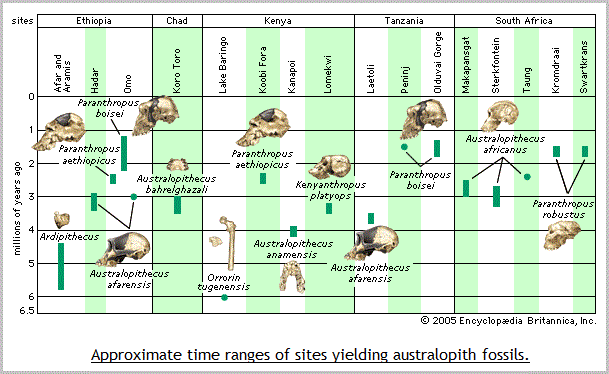 Early species and Australopithecus anamensis Identifying the earliest member of the human tribe (Hominini) is difficult because the predecessors of modern humans are increasingly apelike as the fossil record is followed back through time. They resemble what would be expected in the common ancestor of humans and apes in that they possess a mix of human and ape traits. For example, the earliest species, S. tchadensis, is humanlike in having small canine teeth and a face that does not project very far. However, in most other respects, including brain size, it is apelike. Whether it walked upright is not known because only a single skull, jaw fragments, and teeth have been found. Bipedalism may have been established in the six-million-year-old Orrorin tugenensis, an australopith found in the Tugen Hills near Lake Baringo in central Kenya. In 2001 these fossils were described as the earliest known hominin. O. tugenensis is primitive in most if not all of its body except for femurs (thighbones) that appear to share traits of bipedalism with modern humans. Like later hominins, it has teeth with thick molar enamel, but, unlike humans, it has distinctively apelike canine and premolar teeth. The case for its Hominin status rests on the human-like features of the femur. According to its discoverers, features of the thighbone implying bipedalism include its overall proportions, the internal structure of the knee, and a groove on the bone for a muscle used in upright walking (the obturator externus). Another candidate for the earliest australopith is Ardipithecus (5.8–4.4 mya), found in 1992 at Aramis in the Afar region of Ethiopia. It too is primitive compared with later hominins, though it does share a few evolutionary novelties associated with hominins. Its cranial base is short like that of hominins, and the upper canines are shaped somewhat like those of later species. A well-preserved toe bone shows the characteristically bipedal feature of a base designed for hyper-extension while walking, and bony protrusions that serve as muscle-attachment sites on the pelvis are similar to those found in more advanced hominins. Interestingly, Ardipithecus fossils have been found in association with animals usually found in closed woodland habitats rather than open grasslands. The earliest member of the genus Australopithecus is A. anamensis, discovered in 1994 by a team led by Meave Leakey at Kanapoi and Allia Bay in northern Kenya. The fossils date to 4.2–3.9 mya, and, like Ardipithecus, A. anamensis is associated with woodland animals and a few grassland species as well. It is quite primitive with a strongly protruding lower face, but at the same time it has certain dental features not seen in Ardipithecus ramidus; most conspicuous is a thickening of tooth enamel that becomes characteristic of all later hominins. In addition, the ankle and knee are specialized for upright walking. Other skeletal features are very much like those of later hominins. In 1998 Leakey's team also discovered Kenyanthropus platyops (3.5–3.2 mya) at Lomekwi on the western shore of Lake Turkana in northern Kenya. It too is associated with woodland fauna. It possesses some primitive skull features but shares with early Homo a flat and tall face. Though it overlaps in time with A. afarensis, it appears to be quite distinctive in its morphology and in some respects more primitive. In other respects it resembles much later hominins, particularly H. rudolfensis, in having a relatively flat face and small molars. These traits are related to chewing and thus may be related to diet. It is therefore possible that the resemblances between H. rudolfensis and K. platyops are the result of independent adaptations to similar situations. It is equally possible that the resemblances may imply an evolutionary link between the two. Source: "Australopithecus (genus Australopithecus)." Encyclopædia Britannica Ultimate Reference Suite, 2013. |
So why the short excursion into a description of early humans some may ask. It's because our present primitive perspectives of peace and war (conflict) may well have their origins long ago... suggesting either human evolution has stopped, stalled, or may even be reversing in some respects... and yet some people are obviously moving beyond the old dichotomies (patterns-of-two) which are being preserved by traditions of perspectives established by business, government and religious institutions.
But let us regain our footing on this precipice of dichotomies and return to the discussion of perception... involving the eyes. With respect to the eyes, there are two types of photo-receptors called the cones and rods which have underlying three-part qualitative characteristics:
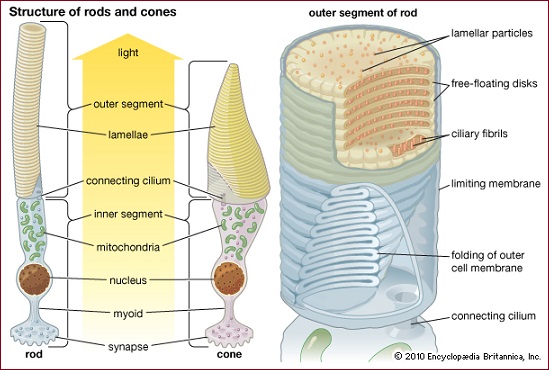 |
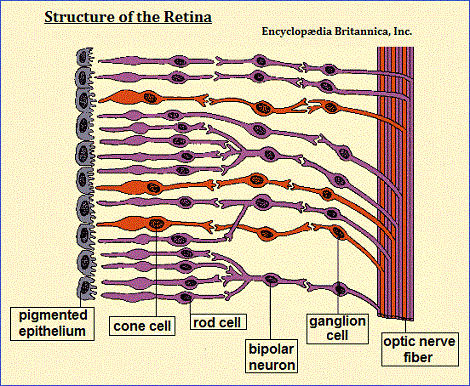 |
|
(Color vision is the) ability to distinguish among various wavelengths of light waves and to perceive the differences as differences in hue. The normal human eye can discriminate among hundreds of such bands of wavelengths as they are received by the colour-sensing cells (cones) of the retina. There are three types of cones, each of which contains a distinctive type of pigment; one cone absorbs longer wavelengths (red light), another middle wavelengths (green light), and the third type shorter wavelengths (blue-violet light). A given colour stimulates all three types of receptors with varying effectiveness, and the pattern of these responses determines the colour perceived. In 1986 researchers identified the genes that correspond to the red, green, and blue pigments. Rod cells function as specialized neurons that convert visual stimuli in the form of photons (particles of light) into chemical and electrical stimuli that can be processed by the central nervous system. Rod cells are stimulated by light over a wide range of intensities and are responsible for perceiving the size, shape, and brightness of visual images. They do not perceive colour and fine detail, tasks performed by the other major type of light-sensitive cell, the cone. Rod cells are much more sensitive to light than cones and are also much more numerous. The human eye contains about 130 million rods and about 7 million cones. Source: "Colour Vision."/"Rod." Encyclopædia Britannica Ultimate Reference Suite, 2013. |
Whereas the cones and the rods each have the capacity to distinguish three separate perceptions, many ideas such as the Peace/War ensemble, are patterned as a group of two. This suggests that there is either an inclination for the eyes to perceive in groups of two, or perceptions are thus being organized by some other mechanism. Let us now look at hearing that has already been discussed on page 2 in this series:
In an analysis of language it is necessary for us to take a look at the mechanism of hearing since an observation of deaf persons reveals the important role that hearing plays:
|
| |
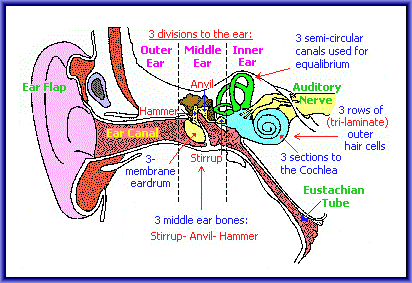 |
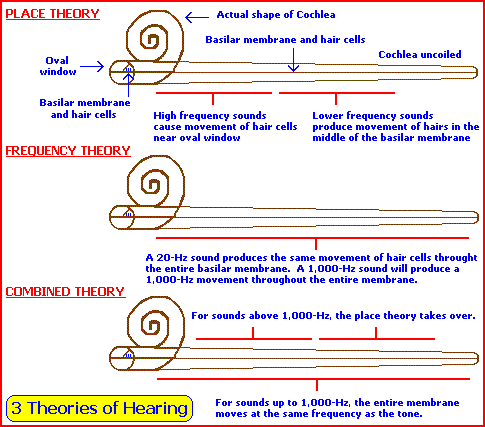 |
| 3 overall divisions: | Outer ear~ Inner ear~ Middle ear |
| 3 middle ear divisions: | Tympanum~ Epitympanum~ Mastoid antrum |
| 3 eardrum membranes: | Cutaneum~ Collagen fibers~ Mucosm |
| 3 semi-circular canals: | Used for balance (equilibrium) |
| 3 bones: | (ossicular chain) Incus~ Stapes~ Malleus |
| 3 main malleus ligaments: | Anterior~ Lateral~ Superior |
| 3 incus anchorage points: | Malleus~ Stapes~ Bony fossa wall |
| 3 cochlea sections: | (Scala) Vestibuli~ Tympani~ Cochlear duct |
| 3 extrinsic muscles (Auricularis): | Anterior~ Superior~ Posterior |
| 3 sound conduction paths: | Electrical~ Mechanical~ Fluid or: Bone (solid)~ Air (gas)~ Fluid (liquid) |
| 3 nerve stimulation paths: | Mechanical~ Chemical~ Electrical |
| 3 outer hair cell rows |
typical in mammals but some sources give 3, 4, or 5 |
| Neurotrophin-3 (NT-3) is synthesized by inner and outer hair cells of the developing organ of Corti. | Brain-derived neurotrophic factor (BDNF) is also synthesized. (Prestin is the motor protein of the outer hair cells.) |
| 3 sound qualities: | Pitch~ Volume (intensity)~ Tone |
| 3 sound wave propagation processes: | Diffraction~ Transmission~ Reflection |
| 3 main forms of ossicular chain fixation: | Fluid~ Mechanical~ Otosclerosis |
| 3 classes of ossicular lever action: | Force arm~ Resistance arm~ Fulcrum |
| 3 acoustic distortion forms: | Frequency~ Phase~ Amplitude |
| 3 basic properties of vibrating bodies: | Inertia~ Elasticity~ Dissipation |
| 3 principal types of deafness: | Conduction~ Nerve~Stimulation |
| 3 types of hearing loss: | Conductive~ Sensorineural~ Mixed |
| 3 (inner ear) organs of balance: | Semicircular canals~ Utricle~ Saccule (collectively called the vestibular organ, which can be referred to as a {3-in-1} ratio.) |
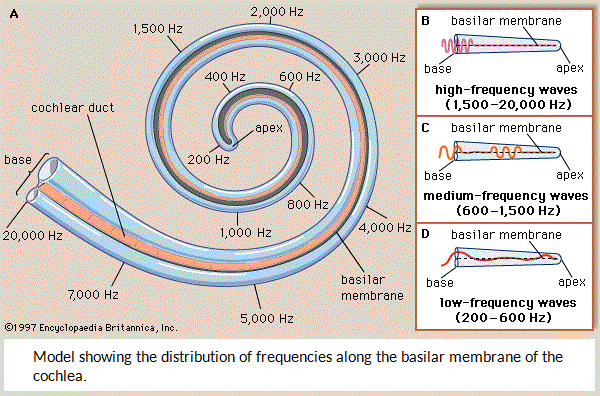
Because of the role hearing plays in language, let's take another look at some representations of language by going back and looking at page 2 in this series.
Date of Origination: Wednesday, 26-Jan-2017... 5:47 AM
Date of initial posting: Wednesday, 08-Feb-2017... 10:41 AM
Updated posting: Saturday, 31-March-2018... 12:08 PM